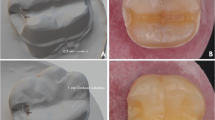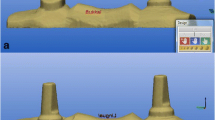Abstract
Objectives
Removable dentures with different denture teeth may provide different performance and resistance in implant and gingival situations, or anterior and posterior applications.
Materials and methods
Two situations of removable dentures were investigated: gingiva (flexible) and implant (rigid) bearing. For simulating the gingiva/jaw situation, the dentures were supported with flexible lining material. For the implant situation, implants (d = 4.1 mm) were screwed into polymethylenmethacrylate (PMMA) resin. Two commercial (Vita-Physiodens MRP, SR Vivodent/Orthotyp DCL) and two experimental materials (EXP1, EXP2) were investigated in anterior (A) and posterior (P) tooth locations. Chewing simulation was performed, and failures were analyzed (microscopy, SEM). Fracture strength of surviving dentures was determined.
Results
Only EXP1 revealed failures during chewing simulation. Failures varied between anterior and posterior locations, and between implant (P:4x; A:7x) or gingiva (P:1x; A:2x) situations. Kaplan-Meier log-rank test revealed significant differences for implant situations (p < 0.002), but not for gingiva bearing (p > 0.093). Fracture testing in the implant situation provided significantly highest values for EXP2 (1476.4 ± 532.2 N) in posterior location, and for DCL (1575.4 ± 264.4 N) and EXP2 (1797.0 ± 604.2 N) in anterior location. For gingival bearing, significantly highest values were found for DCL/P (2148.3 ± 836.3 N), and significantly lowest results for EXP1/A (308.2 ± 115.6 N). For EXP1 + EXP2 + Vita/P and for EXP1/A no significant differences were found between implant- or gingiva-supported situations.
Conclusions
Anterior and posterior teeth showed different material-dependent in vitro performance, further influenced by implant/gingiva bearing. While an implant in anterior application increased fracture strength of two materials, it decreased fracture values of 3/4 of the materials in posterior application.
Clinical relevance
Survival of denture teeth may be influenced by material, oral position, and bearing situation.





Similar content being viewed by others
References
Haraldson T, Carlsson GE (1977) Bite force and oral function in patients with osseointegrated oral implants. Scand J Dent Res 85:200–208
Bakke M, Holm B, Gotfredsen K (2002) Masticatory function and patient satisfaction with implant-supported mandibular overdentures: a prospective 5-year study. Int J Prosthodont 15:575–581
Vallittu PK, Lassila VP, Lappalainen R (1993) Evaluation of damage to removable dentures in two cities in Finland. Acta Odontol Scand 51:363–369
Spratley MH (1987) An investigation of the adhesion of acrylic resin teeth to dentures. J Prosthet Dent 58:389–392
Barpal D, Curtis DA, Finzen F, Perry J, Gansky SA (1998) Failure load of acrylic resin denture teeth bonded to high impact acrylic resins. J Prosthet Dent 80:666–671
Meng GK, Chung K, Fletcher-Stark ML, Zhang H (2010) Effect of surface treatments and cyclic loading on the bond strength of acrylic resin denture teeth with autopolymerized repair acrylic resin. J Prosthet Dent 103:245–252
Patil SB, Naveen BH, Patil NP (2006) Bonding acrylic teeth to acrylic resin denture bases: a review. Gerodontology 23:131–139
Ghazal M, Kern M (2010) Wear of denture teeth and their human enamel antagonists. Quintessence Int 41:157–163
Mello PC, Coppedê AR, Macedo AP, de MdGC M, Rodrigues RCS, Ribeiro RF (2009) Abrasion wear resistance of different artificial teeth opposed to metal and composite antagonists. J Appl Oral Sci 17:451–456
Reis KR, Bonfante G, Pegoraro LF, Conti PCR, Oliveira PCG, Kaizer OB (2008) In vitro wear resistance of three types of polymethyl methacrylate denture teeth. J Appl Oral Sci 16:176–180
Suwannaroop P, Chaijareenont P, Koottathape N, Takahashi H, Arksornnukit M (2011) In vitro wear resistance, hardness and elastic modulus of artificial denture teeth. Dent Mater J 30:461–468
Preis V, Letsch C, Handel G, Behr M, Schneider-Feyrer S, Rosentritt M (2013) Influence of substructure design, veneer application technique, and firing regime on the in vitro performance of molar zirconia crowns. Dent Mater 29:e113–e121
Preis V, Dowerk T, Behr M, Kolbeck C, Rosentritt M (2014) Influence of cusp inclination and curvature on the in vitro failure and fracture resistance of veneered zirconia crowns. Clin Oral Investig 18:891–900
Rosentritt M, Behr M, Van der Zel JM, Feilzer AJ (2009) Approach for valuating the influence of laboratory simulation. Dent Mater 25:348–352
Rosentritt M, Siavikis G, Behr M, Kolbeck C, Handel G (2008) Approach for valuating the significance of laboratory simulation. J Dent 36:1048–1053
Rosentritt M, Behr M, Gebhard R, Handel G (2006) Influence of stress simulation parameters on the fracture strength of all-ceramic fixed-partial dentures. Dent Mater 22:176–182
Aboushelib MN, Feilzer AJ, Kleverlaan CJ (2009) Bridging the gap between clinical failure and laboratory fracture strength tests using a fractographic approach. Dent Mater 25:383–391
Quinn JB, Quinn GD, Kelly JR, Scherrer SS (2005) Fractographic analyses of three ceramic whole crown restoration failures. Dent Mater 21:920–929
Quinn GD (2007) Fractography of ceramics and glasses. NIST recommended practice guide. special publication 960–16. National Institute of Standards and Technology, Washington DC
Abernethy RB (2000) The new Weibull handbook, 4th edn. North Palm Beach, Florida
Brosius G, Brosius F (1995) SPSS, base system and professional statistics, 1st edn. International Thomson Publishing, Bonn
Krejci I, Lutz F (1990) In-vitro test results of the evaluation of dental restoration systems. correlation with in-vivo results. Schweiz Monatschrift Zahnmed 100:1445–1449
Clark TG, Bradburn MJ, Love SB, Altmann DG (2003) Survival analysis part I: basic concepts and first analysis. Br J Cancer 89:232–238
Schwindling FS, Dittmann B, Rammelsberg P (2014) Double-crown-retained removable dental prostheses: a retrospective study of survival and complications. J Prosthet Dent 112:488–493
Behr M, Hofmann E, Rosentritt M, Lang R, Handel G (2000) Technical failure rates of double crown-retained removable partial dentures. Clin Oral Investig 4:87–90
Kawano F, Ohguri T, Ichikawa T, Mizuno I, Hasegawa A (2002) Shock absorbability and hardness of commercially available denture teeth. Int J Prosthodont 15:243–247
Acknowledgments
We would like to thank the manufacturers for providing the materials.
Conflict of interest
The authors declare that they have no competing interests.
Author information
Authors and Affiliations
Corresponding author
Rights and permissions
About this article
Cite this article
Rosentritt, M., Heidtkamp, F., Hösl, H. et al. In vitro comparison of implant- versus gingiva-supported removable dentures in anterior and posterior applications. Clin Oral Invest 20, 275–281 (2016). https://doi.org/10.1007/s00784-015-1502-8
Received:
Accepted:
Published:
Issue Date:
DOI: https://doi.org/10.1007/s00784-015-1502-8




